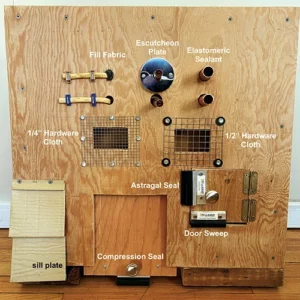
Dr. Frye is the Community Integrated Pest Management (IPM) Extension Educator for Cornell University’s New York State IPM Program. With input from pest management professionals, he recently created an “exclusion board,” pictured below, to provide hands-on IPM inspection training.
1. What was the impetus behind creating an exclusion board?
Adoption and implementation of IPM in schools is a priority for the New York State IPM Program. Over the next couple of years, we will offer workshops around the state that focus on keeping pests out with exclusion. The exclusion board was an idea borrowed from others to help school facilities staff see common openings and learn about practical solutions they can apply on their own.
2. How did you choose what went into it?
We wanted to replicate the types of openings commonly encountered on school building inspections and highlight materials that are both easily accessible and known to effectively exclude different pests at those openings, from insects to rodents. Material selection is a critical part of pest exclusion, and we’ve learned through this process that fire safety regulations play a role in determining which products can be used to seal certain openings. Additionally, there are considerations related to indoor air quality, selecting products that provide weatherization benefits to maintain indoor environments, and accounting for air flow in structures that need to breathe, such as attics and air handling intakes.

3. How do you envision people using it?
Other educators have used demonstration boards to give participants hands-on experience implementing exclusion practices. For example, in workshops, they directly apply sealants, fill fabric, escutcheon plates and other materials to the boards for practice. Our goal is to use these boards to create awareness about pest entry points and initiate conversations on exclusion. We will add a slide ruler and a Frye Inspection Tool so participants can probe openings and see where a mouse or rat can enter. This will help facilities staff visualize how pests get into their facility from outside and how they move through buildings using connected spaces.
4. We realize this version is a prototype. What is your timeline for a final product?
We’re currently assessing materials to keep the design light and portable and deciding which types of openings are most important to show. We’ve asked practitioners for feedback and hope to have the
next version ready to share at workshops as early as this summer.
5. Where can readers learn more about the exclusion board for training their teams and commercial customers?
Cornell’s IPM website collates information on the importance of exclusion, material selection, tool selection and inspections.
Leave A Comment